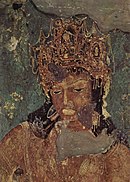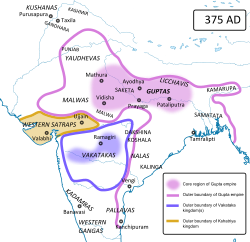Vakataka dynasty
| Vakataka Empire | ||||||||||
| वाकाटक | ||||||||||
|
||||||||||
|
Approximate extent of the Vakataka territories in 375 CE
|
||||||||||
| Capital | Vatsagulma | |||||||||
| Languages |
Sanskrit Maharashtri Prakrit |
|||||||||
| Religion | Hinduism Buddhism |
|||||||||
| Government | Monarchy | |||||||||
| Maharaja | ||||||||||
| • | 250–270 | Vindhyashakti | ||||||||
| • | 270–330 | Pravarasena I | ||||||||
| • | 475–500 | Harishena | ||||||||
| Historical era | Classical India | |||||||||
| • | Established | c. 250 CE | ||||||||
| • | Disestablished | c. 500 CE | ||||||||
|
||||||||||
| Today part of |
|
|||||||||
|
Vakataka dynasty 250 CE–500 CE |
|
 |
 |
| Vindhyashakti | (250–270) |
| Pravarasena I | (270–330) |
| Pravarapura–Nandivardhana branch | |
| Rudrasena I | (330–355) |
| Prithivishena I | (355–380) |
| Rudrasena II | (380–385) |
| Prabhavatigupta (regent) | (385–405) |
| Divakarasena | (385–400) |
| Damodarasena | (400–440) |
| Narendrasena | (440–460) |
| Prithivishena II | (460–480) |
| Vatsagulma branch | |
| Sarvasena | (330–355) |
| Vindhyasena | (355–400) |
| Pravarasena II | (400–415) |
| Unknown | (415–450) |
| Devasena | (450–475) |
| Harishena | (475–500) |
The Vakataka Empire (IAST: Vākāṭaka) was a dynasty from the Indian subcontinent that originated from the Deccan in the mid-3rd century CE. Their state is believed to have extended from the southern edges of Malwa and Gujarat in the north to the Tungabhadra River in the south as well as from the Arabian Sea in the west to the edges of Chhattisgarh in the east. They were the most important successors of the Satavahanas in the Deccan and contemporaneous with the Guptas in northern India.
The Vakataka dynasty was a Brahmin dynasty. Little is known about Vindhyashakti (c. 250 – c. 270 CE), the founder of the family. Territorial expansion began in the reign of his son Pravarasena I. It is generally believed that the Vakataka dynasty was divided into four branches after Pravarasena I. Two branches are known and two are unknown. The known branches are the Pravarapura-Nandivardhana branch and the Vatsagulma branch. The Gupta emperor Chandragupta II married his daughter into Vakataka royal family and with their support annexed Gujarat from the Saka Satraps in 4th century CE. The Vakataka power was followed by that of the Chalukyas of Badami in Deccan.
The Vakatakas are noted for having been patrons of the arts, architecture and literature. They led public works and their monuments are a visible legacy. The rock-cut Buddhist viharas and chaityas of Ajanta Caves (a UNESCO World Heritage Site) were built under the patronage of Vakataka emperor, Harishena.
...
Wikipedia


